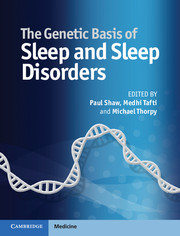20 results
Section 1 - Generalprinciples of genetics and genomics
-
- Book:
- The Genetic Basis of Sleep and Sleep Disorders
- Published online:
- 05 November 2013
- Print publication:
- 24 October 2013, pp 1-32
-
- Chapter
- Export citation
Section 2 - Geneticsof sleep and circadian rhythms
-
- Book:
- The Genetic Basis of Sleep and Sleep Disorders
- Published online:
- 05 November 2013
- Print publication:
- 24 October 2013, pp 33-138
-
- Chapter
- Export citation
Abbreviations
-
- Book:
- The Genetic Basis of Sleep and Sleep Disorders
- Published online:
- 05 November 2013
- Print publication:
- 24 October 2013, pp xv-xviii
-
- Chapter
- Export citation
Chapter 27 - Genetics of recurrent hypersomnia
- from Section 5 - Narcolepsyand hypersomnias
-
-
- Book:
- The Genetic Basis of Sleep and Sleep Disorders
- Published online:
- 05 November 2013
- Print publication:
- 24 October 2013, pp 272-278
-
- Chapter
- Export citation
Section 7 - Circadian rhythm sleep disorders
-
- Book:
- The Genetic Basis of Sleep and Sleep Disorders
- Published online:
- 05 November 2013
- Print publication:
- 24 October 2013, pp 313-334
-
- Chapter
- Export citation
The Genetic Basis of Sleep and Sleep Disorders - Half title page
-
- Book:
- The Genetic Basis of Sleep and Sleep Disorders
- Published online:
- 05 November 2013
- Print publication:
- 24 October 2013, pp i-ii
-
- Chapter
- Export citation
Contributors
-
-
- Book:
- The Genetic Basis of Sleep and Sleep Disorders
- Published online:
- 05 November 2013
- Print publication:
- 24 October 2013, pp xi-xiv
-
- Chapter
- Export citation
Section 6 - Sleep-related breathing disorders
-
- Book:
- The Genetic Basis of Sleep and Sleep Disorders
- Published online:
- 05 November 2013
- Print publication:
- 24 October 2013, pp 279-312
-
- Chapter
- Export citation
Section 3 - Sleepphysiology and homeostasis
-
- Book:
- The Genetic Basis of Sleep and Sleep Disorders
- Published online:
- 05 November 2013
- Print publication:
- 24 October 2013, pp 139-226
-
- Chapter
- Export citation

The Genetic Basis of Sleep and Sleep Disorders
-
- Published online:
- 05 November 2013
- Print publication:
- 24 October 2013
Section 8 - Parasomniasand sleep-related movement disorders
-
- Book:
- The Genetic Basis of Sleep and Sleep Disorders
- Published online:
- 05 November 2013
- Print publication:
- 24 October 2013, pp 335-350
-
- Chapter
- Export citation
The Genetic Basis of Sleep and Sleep Disorders - Title page
-
-
- Book:
- The Genetic Basis of Sleep and Sleep Disorders
- Published online:
- 05 November 2013
- Print publication:
- 24 October 2013, pp iii-iii
-
- Chapter
- Export citation
Section 5 - Narcolepsyand hypersomnias
-
- Book:
- The Genetic Basis of Sleep and Sleep Disorders
- Published online:
- 05 November 2013
- Print publication:
- 24 October 2013, pp 235-278
-
- Chapter
- Export citation
Section 9 - Psychiatricand medical disorders
-
- Book:
- The Genetic Basis of Sleep and Sleep Disorders
- Published online:
- 05 November 2013
- Print publication:
- 24 October 2013, pp 351-374
-
- Chapter
- Export citation
Contents
-
- Book:
- The Genetic Basis of Sleep and Sleep Disorders
- Published online:
- 05 November 2013
- Print publication:
- 24 October 2013, pp v-vi
-
- Chapter
- Export citation
Section 4 - Insomnias
-
- Book:
- The Genetic Basis of Sleep and Sleep Disorders
- Published online:
- 05 November 2013
- Print publication:
- 24 October 2013, pp 227-234
-
- Chapter
- Export citation
Copyright page
-
- Book:
- The Genetic Basis of Sleep and Sleep Disorders
- Published online:
- 05 November 2013
- Print publication:
- 24 October 2013, pp iv-iv
-
- Chapter
- Export citation
Section 10 - Medication effects
-
- Book:
- The Genetic Basis of Sleep and Sleep Disorders
- Published online:
- 05 November 2013
- Print publication:
- 24 October 2013, pp 375-380
-
- Chapter
- Export citation
Index
-
- Book:
- The Genetic Basis of Sleep and Sleep Disorders
- Published online:
- 05 November 2013
- Print publication:
- 24 October 2013, pp 381-399
-
- Chapter
- Export citation
Chapter 14 - Genetics of sleep and EEG
- from Section 3 - Sleepphysiology and homeostasis
-
-
- Book:
- The Genetic Basis of Sleep and Sleep Disorders
- Published online:
- 05 November 2013
- Print publication:
- 24 October 2013, pp 139-146
-
- Chapter
- Export citation



